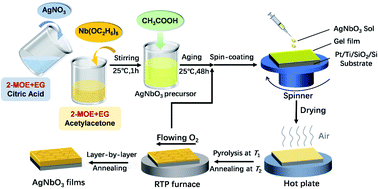Phase-pure antiferroelectric AgNbO3 films on Si substrates: chemical solution deposition and phase transitions†
Abstract
AgNbO3-based antiferroelectric films have attracted emerging attention in the field of dielectric energy storage and possess promising applications in photocatalysis and microwave devices. Unfortunately, it remains a challenge to fabricate pure-phase AgNbO3 films on Si substrates, precluding their further integration into electronic devices. Here, we, for the first time, report phase-pure AgNbO3 films on Pt/Ti/SiO2/Si substrates by a chemical solution deposition (CSD) method. A facile CSD route without using the hazardous pyridine additive is demonstrated to obtain a stable AgNbO3 precursor for spin-coating films. By comprehensively controlling the heat treatment conditions, secondary phases are eliminated in the deposited films. The phase transitions of the AgNbO3 films are also investigated, where intriguingly the room temperature phase is determined to be the antiferroelectric M2 phase, rather than the commonly reported M1 phase in bulk AgNbO3. Meanwhile, the relative dielectric permittivity surpasses 300 at room temperature and maintains at ∼400 with low dielectric loss (<0.05; measured at frequencies of 0.1–1 MHz) over a wide temperature range of 150–350 °C, within a 5% variation. This work provides an easy-to-implement process of AgNbO3 films which may attract scientific interests and potential applications.



 Please wait while we load your content...
Please wait while we load your content...